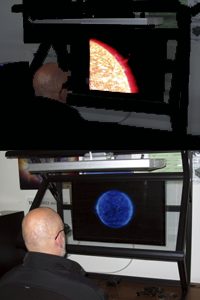U.S. Naval Research Laboratory views first true 3D images ever captured of the Sun using EVL-invented display technology
May 10th, 2007
Categories: Applications, Devices, Visualization

About
Solar physicists at the Naval Research Laboratory (NRL) are viewing impressive solar disturbances whose depth and violent nature are now clearly visible in the first true stereoscopic images ever captured of the Sun.
These new views, recently released by NASA, are providing scientists with unprecedented insight into solar physics and the violent solar weather events that can bombard Earth’s magnetosphere with particles and affect systems ranging from weather to our electrical grids.
NRL scientists are viewing the high-resolution stereo pairs on an ImmersaDesk4 (I-Desk4) display system specifically commissioned and installed at the laboratory last summer in anticipation of the release of the data.
The I-Desk4, invented at the University of Illinois at Chicago’s (UIC) Electronic Visualization Laboratory (EVL), is a tracked, 4-million-pixel display system driven by a 64-bit graphics workstation. Its compact workstation design is comprised of two 30-inch Apple LCD monitors mounted with quarter-wave plates and bisected by a half-silvered mirror enable circular polarization. Multiple users can view the head-tracked 3D scene using lightweight polarized glasses.
The stereo video pairs come from NASA’s Solar Terrestrial Relations Observatory (STEREO) mission, a pair of satellites launched in October 2006 that began circling the Sun in January 2007. One satellite is slightly ahead of Earth in its orbit around the sun, the other is slightly behind, which provides the separation needed to achieve stereo depth perception.
The Solar Physics Branch at NRL developed the SECCHI (Sun Earth Connection Coronal and Heliospheric Investigation) suite of telescopes for the spacecraft. The high-resolution sensor suite includes coronagraphs, wide-angle cameras and an Extreme Ultraviolet Imager. The sensors generate 10 synchronized video feeds, each up to 2K by 2K pixels.
In summer 2006, EVL student Cole Krumbholz worked with NRL solar physicist Dr. Angelos Vourlidas to help establish a solar imagery display environment at NRL. Krumbholz helped build two EVL-developed display systems capable of viewing and managing files on the scale of thousands of pixels per square inch: a nine-panel tiled LCD wall ideal for viewing high-resolution 2D imagery, and an I-Desk4 for viewing high-resolution 3D imagery.
The tiled wall is capable of synchronously displaying multiple high-resolution video streams. NRL scientists can also composite the sensor data into a single video to conduct a multi-spectral analysis, and view multiple days of video. Krumbholz implemented a distributed video-rendering tool with interactive features such as pan, zoom and crop.
Violent solar weather, especially that caused by a destructive type of solar eruption called Coronal Mass Ejection (CME), can blast magnetic fields capable of disrupting satellites in space and power grids and radio transmissions on Earth. The new 3D imagery will help monitor the front of a CME cloud to allow scientists to take preventative measures and issue warnings.
ABOUT THE IMMERSADESK®
ImmersaDesk (I-Desk, 1994), ImmersaDesk2 (I-Desk2, 1996), ImmersaDesk3 (I-Desk3, 1998) and ImmersaDesk4 (I-Desk4, 2005) are all inventions of University of Illinois at Chicago’s (UIC) Electronic Visualization Laboratory (EVL). Each generation of I-Desk has attempted to leverage emerging virtual reality display technologies to provide more compact, higher resolution, and less cumbersome stereoscopic viewing.
The original I-Desk was an active stereo, projection-based, tracked, large-screen, virtual-reality (VR) display environment driven by a desk-side SGI Onyx; I-Desk2 had a similar format and included the ability to tilt its screen from zero to 45 degrees; I-Desk3 was a transitional format that used a 50-inch plasma panel and was driven by an SGI Octane; the I-Desk4 is a passive-stereo, tracked, 4-million-pixel display system comprised of two 30-inch Apple LCD monitors mounted with quarter-wave plates and bisected by a half-silvered mirror to enable circular polarization and is driven by a commodity graphics workstation.
ImmersaDesk is a registered trademark of the University of Illinois Board of Trustees.
See www.evl.uic.edu/core.php?mod=4&type=1&indi=313
By Laura Wolf, Project Coordinator, EVL / UIC
laura@evl.uic.edu
Contact:
Janice Schultz
Public Affairs Office
Naval Research Laboratory
202.767.2541
nlpao @ nrl.navy.mil